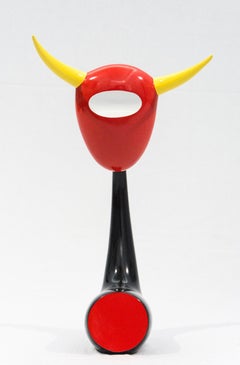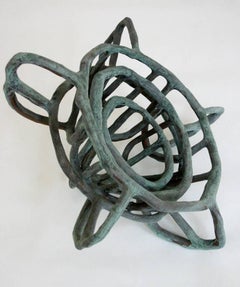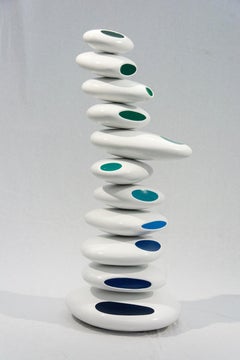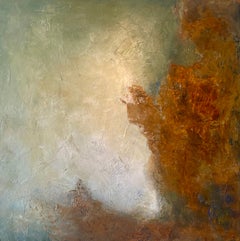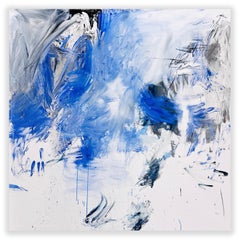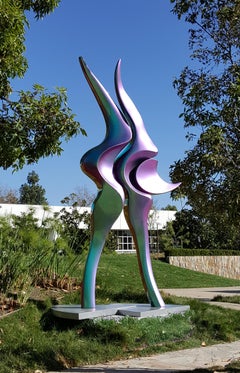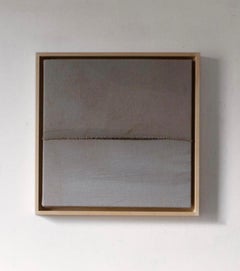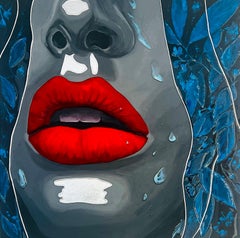Art by Medium: Putty
to
2
2
2
3
3
6
Overall Width
to
Overall Height
to
2
14
6
6
1
1
3
3
2
1
1
1
1
1
1
1
1
1
1
1
1
1
1
16
184,008
96,966
77,927
75,935
4
4
1
1
1
1
1
10
2
Medium: Putty
Vanessa (Flowers series) - modern, abstract, contemporary, fiberglass sculpture
By Benny Katz
Located in Bloomfield, ON
This minimalist abstract sculpture is by artist Benny Katz.
A bouquet of flowers is the inspiration for this fun, glossy, brightly coloured table-top sculpture by the Israel-based a...
Category
2010s Contemporary Art by Medium: Putty
Materials
Metal
Bull - playful, modern, abstract, contemporary, tabletop, fibreglass sculpture
By Benny Katz
Located in Bloomfield, ON
The distinctive shape of a bull’s head attached to a horn-like stand pops in glossy bright colours of red, yellow and black in this whimsical sculpture by Benny Katz. As a former gra...
Category
2010s Contemporary Art by Medium: Putty
Materials
Metal
Loren Eiferman, Satellite, 2010, 125 pieces of wood, copper, patina
Located in Darien, CT
Over many decades Loren Eiferman has created and mastered a unique technique of working with wood—her primary material.
First, she begins with a drawing of an idea. Then she take...
Category
2010s Abstract Art by Medium: Putty
Materials
Copper
Ocean - small stacked sculpture of white ovals, with blue and green highlights
By Benny Katz
Located in Bloomfield, ON
In stacked glossy ovals of white, highlighted in blue and green, Israeli-based sculptor Benny Katz creates the playful essence of a ocean waves. This work is number 2 in an edition ...
Category
2010s Contemporary Art by Medium: Putty
Materials
Metal
Extra-Large Skyscape Dramatic And Structured Heaven By Alejandro Hermann
By Alejandro Hermann
Located in Frederiksberg C, DK
Introducing an extra-large painting, measuring an impressive 180cm x 180cm/70,9in x 70,9 in by the visionary artist Alejandro Hermann. Within this painting you experience an contempo...
Category
Late 20th Century Contemporary Art by Medium: Putty
Materials
Acrylic, Wood Panel, Putty
Expedition (Abstract Painting)
Located in London, GB
Artwork is exclusive to IdeelArt.
Knaut builds her compositions slowly over time, adding layers of colors and materials and then scraping them away, working them over and over. Gest...
Category
2010s Abstract Art by Medium: Putty
Materials
Canvas, Plaster, Ink, Acrylic, Pigment, Putty
Joseph Fucigna, Green/Red Putty Drip, 2018, Silicone, House Paint, Wood Panel
Located in Darien, CT
Joseph Fucigna is a multi-media artist whose work is rooted in process, play and the innate qualities of the materials used. Through experimentation, play and innovation he creates sculptures, paintings and drawings that are known for their power to transform materials, inventiveness and odd but suggestive subject matter. The ultimate goal is to create an artwork that is a perfect balance between suggestive content, and the formal qualities of the material that allow both to be active participants.
Joseph Fucigna received his Masters of Fine Arts degree from the School of Visual Arts in New York City. He also attended the Triangle Workshop in Pine Plains, NY and worked with the renowned sculptor Sir Anthony Caro and critic Clement Greenberg.
Fucigna is a full-time Professor of Art at Norwalk Community College and is the Chair of the Studio Arts Program. Fucigna has also taught in the Art Department at the State University of New York, Stony Brook. Presently, he resides and works in Weston, CT.
Fucigna has exhibited nationally including shows at the Fitchburg Art Museum in Massachusetts, Real Art Ways in Connecticut, the United Nations, Grounds for Sculpture in New Jersey, the Lyman Allyn Art Museum in Connecticut, the New York State Museum in Albany, NY and the Burchfield Art Center in Buffalo NY.
He has had one-person exhibitions at the Fred Giampietro Gallery, Sculpture Barn, Norwalk Community College Art Gallery, Artist Space New Haven and the Bannister...
Category
2010s Arte Povera Art by Medium: Putty
Materials
Silicone, House Paint, Wood Panel, Putty
Arnold - playful body builder - black and white with red, yellow and green
By Benny Katz
Located in Bloomfield, ON
Using smooth, minimalist forms in black with bright green, blue, red and white, Israeli-based sculptor Benny Katz creates the playful essence of a body builder...
Category
2010s Contemporary Art by Medium: Putty
Materials
Metal
Loren Eiferman, Voynich #1, 124 Pieces of Wood, 2015, Wood, Putty, 54x30x20 in
Located in Darien, CT
Over many decades Loren Eiferman has created and mastered a unique technique of working with wood—her primary material.
First, she begins with a drawing of an idea. Then she takes a daily walk in the woods surrounding her studio and collects tree limbs and long sticks that have fallen to the ground. She never chops down a living tree or uses green wood. Eiferman allows the wood time to cure in the studio to make sure it won’t check or crack.
Next, she debarks the branch and looks for shapes found within each piece of wood. Using a Japanese hand saw, she cuts and connect these small shapes together using dowels and wood glue. Then, all the open joints get filled with a home made putty, which is then sanded so she can see the newly formed shapes. This process is until the new sculpture appears like the original line drawing but in space. She wants the work to appear as if it grew in nature, when in fact each sculpture is composed of over 100 small pieces of wood that are seamlessly jointed together. Her work can be called the ultimate recycling: taking the detritus of nature and giving it a new life.
We have all at one point or another picked up a stick from the ground—touched the wood, peeled the bark off with our fingernails. Her work taps into that same primal desire of touching nature and being close to it. Trees connect us back to nature, back to this Earth. Her work has a meditative quality to it—a quiet, calming energy.
Her influences are many; from looking at nature and plant life on this Earth to researching the heavenly bodies in the images beamed back from the Hubble Telescope. From studying ancient Buddhist mandalas and designs to delving deeper into quantum physics. And from researching mysterious manuscripts to studying the patterns inside our brains.
For Invocation, we are exhibiting her newest body of work, inspired by the illustrations found in the Voynich Manuscript. This 250-page book, is believed to have been written in the early 15th century, of a mysterious origin and purpose.
Written in an unknown language and currently housed at Yale University’s Beinecke Rare Book Library, the manuscript has eluded all attempts in the intervening centuries to decode or decipher its purpose and meaning. This enigmatic book is divided into 6 different sections (herbal, astronomical, biological, cosmological, pharmaceutical and recipes).
Having discovered the images contained in this codex over the Internet, Eiferman felt an immediate, profound and inexplicable connection to this manuscript and its creator.
The artist is currently transposing the “herbal” section of manuscript into sculptures. This section has drawings in it of plants and flowers that do not really exist in nature—past or present. These aren’t just pretty images of flowers—they also contain the wacky root systems and seemingly out of proportion leaves, stamens and pistils.
Loren Eiferman was born in Brooklyn, NY. She received her BFA from SUNY Purchase. Her work has been exhibited extensively throughout the Tri-State region including gallery and museum exhibitions in the Hudson Valley and Connecticut. Her work is included in numerous corporate and private art collections.
In 2014 she was awarded a NYC MTA Arts & Design art commission to produce steel railings...
Category
2010s Abstract Art by Medium: Putty
Materials
Wood, Putty
Jo Yarrington, Lick, Dip, Paint, 2018, LED Light, Putty, Plastic
Located in Darien, CT
This installation imagines a dipping pot that the Radium Girls might have had at a work station. Lit by black light to highlight the neon glow, this object conveys a modern view on t...
Category
2010s Conceptual Art by Medium: Putty
Materials
Plastic, LED Light, Putty
Loren Eiferman, Galaxy, 129 Pieces of Wood, 2012, Wood, Putty, Wood Sculpture
Located in Darien, CT
Over many decades Loren Eiferman has created and mastered a unique technique of working with wood—her primary material.
First, she begins with a drawing of an idea. Then she takes a daily walk in the woods surrounding her studio and collects tree limbs and long sticks that have fallen to the ground. She never chops down a living tree or uses green wood. Eiferman allows the wood time to cure in the studio to make sure it won’t check or crack.
Next, she debarks the branch and looks for shapes found within each piece of wood. Using a Japanese hand saw, she cuts and connect these small shapes together using dowels and wood glue. Then, all the open joints get filled with a home made putty, which is then sanded so she can see the newly formed shapes. This process is until the new sculpture appears like the original line drawing but in space. She wants the work to appear as if it grew in nature, when in fact each sculpture is composed of over 100 small pieces of wood that are seamlessly jointed together. Her work can be called the ultimate recycling: taking the detritus of nature and giving it a new life.
We have all at one point or another picked up a stick from the ground—touched the wood, peeled the bark off with our fingernails. Her work taps into that same primal desire of touching nature and being close to it. Trees connect us back to nature, back to this Earth. Her work has a meditative quality to it—a quiet, calming energy.
Her influences are many; from looking at nature and plant life on this Earth to researching the heavenly bodies in the images beamed back from the Hubble Telescope. From studying ancient Buddhist mandalas and designs to delving deeper into quantum physics. And from researching mysterious manuscripts to studying the patterns inside our brains.
For Invocation, we are exhibiting her newest body of work, inspired by the illustrations found in the Voynich Manuscript. This 250-page book, is believed to have been written in the early 15th century, of a mysterious origin and purpose.
Written in an unknown language and currently housed at Yale University’s Beinecke Rare Book Library, the manuscript has eluded all attempts in the intervening centuries to decode or decipher its purpose and meaning. This enigmatic book is divided into 6 different sections (herbal, astronomical, biological, cosmological, pharmaceutical and recipes).
Having discovered the images contained in this codex over the Internet, Eiferman felt an immediate, profound and inexplicable connection to this manuscript and its creator.
The artist is currently transposing the “herbal” section of manuscript into sculptures. This section has drawings in it of plants and flowers that do not really exist in nature—past or present. These aren’t just pretty images of flowers—they also contain the wacky root systems and seemingly out of proportion leaves, stamens and pistils.
Loren Eiferman was born in Brooklyn, NY. She received her BFA from SUNY Purchase. Her work has been exhibited extensively throughout the Tri-State region including gallery and museum exhibitions in the Hudson Valley and Connecticut. Her work is included in numerous corporate and private art collections.
In 2014 she was awarded a NYC MTA Arts & Design art commission to produce steel railings...
Category
2010s Abstract Art by Medium: Putty
Materials
Wood, Putty
Loren Eiferman, Winter Solstice, 2012, 165 Pieces of Wood, Putty, Wood Sculpture
Located in Darien, CT
Over many decades Loren Eiferman has created and mastered a unique technique of working with wood—her primary material.
First, she begins with a drawing of an idea. Then she takes a daily walk in the woods surrounding her studio and collects tree limbs and long sticks that have fallen to the ground. She never chops down a living tree or uses green wood. Eiferman allows the wood time to cure in the studio to make sure it won’t check or crack.
Next, she debarks the branch and looks for shapes found within each piece of wood. Using a Japanese hand saw, she cuts and connect these small shapes together using dowels and wood glue. Then, all the open joints get filled with a home made putty, which is then sanded so she can see the newly formed shapes.
This process is until the new sculpture appears like the original line drawing but in space. She wants the work to appear as if it grew in nature, when in fact each sculpture is composed of over 100 small pieces of wood that are seamlessly jointed together.
Her work can be called the ultimate recycling: taking the detritus of nature and giving it a new life. We have all at one point or another picked up a stick from the ground—touched the wood, peeled the bark off with our fingernails. Her work taps into that same primal desire of touching nature and being close to it. Trees connect us back to nature, back to this Earth. Her work has a meditative quality to it—a quiet, calming energy.
Her influences are many; from looking at nature and plant life on this Earth to researching the heavenly bodies in the images beamed back from the Hubble Telescope. From studying ancient Buddhist mandalas and designs to delving deeper into quantum physics. And from researching mysterious manuscripts to studying the patterns inside our brains.
Her newest body of work is inspired by the illustrations found in the Voynich Manuscript. This 250-page book, is believed to have been written in the early 15th century, of a mysterious origin and purpose.
Written in an unknown language and currently housed at Yale University’s Beinecke Rare Book Library, the manuscript has eluded all attempts in the intervening centuries to decode or decipher its purpose and meaning. This enigmatic book is divided into 6 different sections (herbal, astronomical, biological, cosmological, pharmaceutical and recipes).
Having discovered the images contained in this codex over the Internet, Eiferman felt an immediate, profound and inexplicable connection to this manuscript and its creator.
The artist is currently transposing the “herbal” section of manuscript into sculptures. This section has drawings in it of plants and flowers that do not really exist in nature—past or present. These aren’t just pretty images of flowers—they also contain the wacky root systems and seemingly out of proportion leaves, stamens and pistils.
Loren Eiferman was born in Brooklyn, NY. She received her BFA from SUNY Purchase.
Her work has been exhibited extensively throughout the Tri-State region including gallery and museum exhibitions in the Hudson Valley and Connecticut.
Her work is included in numerous corporate and private art collections.
In 2014 she was awarded a NYC MTA Arts & Design art commission to produce steel railings...
Category
2010s Abstract Art by Medium: Putty
Materials
Wood, Putty
Large Mid-Century Modern Abstract Cityscape Painting by Henriette Yetti Stolz
Located in Denver, CO
This dramatic mid-century oil and spackle painting by Henriette “Yetti” Stolz (American, 20th century) presents a bold abstract interpretation of a cityscape, featuring a dynamic bri...
Category
Mid-20th Century American Modern Art by Medium: Putty
Materials
Oil, Putty
Post Concentric Episode Bone Diptych
By Kris Cox
Located in Phoenix, AZ
Pigment wood putty, acrylic, Dorland's wax medium on wood panel
signature and year on verso
Constructed paintings comprise the Concentric and Post Concentric Episode Series. They ar...
Category
2010s Abstract Art by Medium: Putty
Materials
Wax, Acrylic, Wood Panel, Pigment, Putty
Contemporary, Mixed Media, Ceramic, Sculpture, Functional Mug, Utilitarian
By Matt Mitros
Located in St. Louis, MO
Contemporary, Mixed Media, Ceramic, Sculpture, Functional Mug, Utilitarian
Matt Mitros was born in Philadelphia, PA. Upon completing his BFA at Penn State University, he was an Arti...
Category
2010s Contemporary Art by Medium: Putty
Materials
Ceramic, Resin, Plastic, Putty
Aggressive Reflection, dreamlike still life female form expressive
Located in Brooklyn, NY
*ABOUT Stephen Basso
Stephen Basso's highly original pastels and oil paintings are romantic, yet thought provoking fantasies. His whimsical works are alive with boundless imagina...
Category
2010s Expressionist Art by Medium: Putty
Materials
Platinum
Related Items
FLAME
By Lyle London
Located in Tempe, AZ
This abstraction of the ethereal beauty of open flame is painted with a special automotive paint that shifts color from magenta to jade green or both depending on point of view and a...
Category
2010s Contemporary Art by Medium: Putty
Materials
Fiberglass, Other Medium
ABSTRACT Landscape Painting by Gold Contemporary Spanish Artist Pau Escat 2023
By Pau Escat
Located in Barcelona, Barcelona
Colt Seager (b. 1993) is an American painter and sculptor based near Chicago, IL. Drawing inspiration from the inherent holiness and tranquility of the natural world, Seager’s work i...
Category
2010s Abstract Art by Medium: Putty
Materials
Cotton Canvas, Ink, Acrylic, Pigment
$1,054 Sale Price
20% Off
H 16.93 in W 16.93 in D 1.19 in
River Agate Study (6)
Located in Bozeman, MT
Though the action of painting geological formations using abstraction, organic textures and luminous color, I can convey how natural physical forces work to shape a constantly changi...
Category
2010s Contemporary Art by Medium: Putty
Materials
Acrylic, Wood Panel
FARAWAY LAND
By Arturo Mallmann
Located in Three Oaks, MI
Arturo Mallmann’s abstract landscapes radiate a shiny gloss that makes them appear as glass canvases, but they are not in fact glass. Mallmann’s process includes a complicated approa...
Category
2010s Contemporary Art by Medium: Putty
Materials
Epoxy Resin, Acrylic, Wood Panel
Wave of Whispers contemporary modern organic beige wall sculpture
Located in Doetinchem, NL
"Wave of Whispers" is a contemporary modern abstract wall sculpture by UK artist Mari-Ruth Oda. Made from Bath Stone Jesmonite, a fine art composite material based on acrylic resin, ...
Category
2010s Contemporary Art by Medium: Putty
Materials
Stone
$1,138 Sale Price
40% Off
H 9.85 in W 9.85 in D 2.76 in
Synthesism: Solitude 2 - Large Original Abstract Artwork on Canvas
Located in Los Angeles, CA
Abstract minimalist artist Jason DeMeo presents a collection of artworks designed to engage viewers in a meditative experience, drawing them closer to the enduring ideals of truth, b...
Category
21st Century and Contemporary Abstract Art by Medium: Putty
Materials
Gold Leaf
$4,000 Sale Price
20% Off
H 74 in W 48 in
Partly Perpendicular (Abstract Geometric Painting in Red, Orange, Green & Blue)
Located in Hudson, NY
Colorful abstract geometric painting in various shades of red, orange, green and blue, with accents of white, black, pink and light yellow
"Partly Perpendicular", made by Hudson Vall...
Category
2010s Abstract Art by Medium: Putty
Materials
Canvas, Plaster, Wax, Acrylic, Pigment
Vincent PomilioPartly Perpendicular (Abstract Geometric Painting in Red, Orange, Green & Blue), 2020
$3,600
H 36 in W 36 in D 1.5 in
Time Bomb Grenade
By Dan Tanenbaum
Located in Dallas, TX
Dan Tanenbaum lives and works in Toronto. His work with watch parts began in 2010, when he stopped by to see his regular watch supplier. He noticed a buc...
Category
21st Century and Contemporary Contemporary Art by Medium: Putty
Materials
Metal
Here contemporary modern organic beige wall sculpture
Located in Doetinchem, NL
"Here" is a contemporary modern abstract wall sculpture by UK artist Mari-Ruth Oda. Made from Bath Stone Jesmonite, a fine art composite material based on acrylic resin, fiberglass a...
Category
2010s Contemporary Art by Medium: Putty
Materials
Stone
$1,138 Sale Price
40% Off
H 9.85 in W 9.85 in D 2.76 in
Voyeur, Cityscape, Black, White, Textured, Buildings, Architectural
By Jason Wright
Located in Riverdale, NY
Voyeur is a monochromatic architectural painting and a cityscape. It is Oil and Acrylic on Wood Panel, 30x30. It is sold individually or as a diptych with Ruled by Shapes/Destroyed by Geometry.
Jason Wright was born in the United States (1975). He studied Painting and Graphic Design at the Corcoran College of Art and Design in Washington, DC. Jason was immersed in art from a young age, illustrating and designing graphics for the surfing, skateboarding, and snowboarding industry. Apart from his current body of work, he is an accomplished mix media painter, as well as a medaled action sports athlete.
His current work focuses on the theory of shelter, and explores the relationship between the simplistic shape of a home and it's ever presence in our lives, his work is generally rendered in a dusk, dawn, or full moon setting. Wright’s passion for HDR and long exposure photography...
Category
2010s Contemporary Art by Medium: Putty
Materials
Oil, Acrylic, Wood Panel
$3,500
H 30 in W 30 in D 2 in
Copper Rings Mesh
Located in New York, NY
Daniela Cutait studied fine arts at FAAP in Sao Paulo in the early 1990s and has always been curious, creative, communicative and restless. The artist orbited through the universe of...
Category
21st Century and Contemporary Abstract Art by Medium: Putty
Materials
Copper
Grey Amphora by Pavlína Kvita-Contemporary sculpture, futuristic abstract figure
Located in Paris, FR
Grey Amphora is a glass fiber and reinforced concrete sculpture by Czech contemporary artist Pavlína Kvita, notable for its distinctive surface details—unusual within the artist’s br...
Category
2010s Contemporary Art by Medium: Putty
Materials
Concrete
$13,657
H 72.84 in W 55.12 in D 35.44 in
Previously Available Items
Rain Kiss. Sculptural 3D artwork
Located in Zofingen, AG
Unique and one-of-a-kind piece with female lips and a nature accent. Sculptural 3d red lips on a grey-blue background. The contours of the face as well as the flowers are made with t...
Category
2010s Pop Art Art by Medium: Putty
Materials
Silver, Foil
Fresco "Private garden " 60x40cm, wood, putty, acrylic
Located in Yerevan, AM
Fresco ,60x40cm, wood, putty, acrylic
Category
2010s Abstract Art by Medium: Putty
Materials
Wood, Acrylic, Putty
Fresco "In your garden " 40x30cm, wood, putty, acrylic
Located in Yerevan, AM
Fresco ,40x30cm, wood, putty, acrylic
Category
2010s Abstract Art by Medium: Putty
Materials
Wood, Acrylic, Putty
Leslie (Flowers Series) - modern, abstract, contemporary, fiberglass sculpture
By Benny Katz
Located in Bloomfield, ON
Funky and fun, this glossy, brightly coloured sculpture by Benny Katz is a contemporary ‘take’ on a bouquet of flowers. To create his ‘flower series’ the Israel-based artist has used...
Category
2010s Contemporary Art by Medium: Putty
Materials
Metal
Modernist Abstract Winter Landscape Textured Oil Painting, Gray Brown, White
Located in Denver, CO
Signed and dated oil, spackle and pen on board portraying an abstract winter landscape by artist Henriette "Yetti" Stolz (1935-Present). Artwork features dark greys, yellow, gold, an...
Category
20th Century American Modern Art by Medium: Putty
Materials
Oil, Pen, Putty
H 36.75 in W 29.25 in D 0.75 in
Flowers - playful abstract interior sculpture in red, blue, yellow and black
By Benny Katz
Located in Bloomfield, ON
Using bright, primary colors and minimalist forms Katz creates the playful essence of a bouquet of flowers. Infused with humor with a touch of whimsy, the work aligns with the innov...
Category
2010s Contemporary Art by Medium: Putty
Materials
Metal
H 26 in W 22 in D 18 in
Performance - abstract interior red, blue, yellow and black playful sculpture
By Benny Katz
Located in Bloomfield, ON
Embracing minimalist forms in glossy primary colors, Israeli-based sculptor Benny Katz creates the playful essence of a performer. Imbued with humor, this delightful work aligns wit...
Category
2010s Contemporary Art by Medium: Putty
Materials
Metal
Loren Eiferman, Black Hole, 244 pieces of wood, 2012, Wood Sculpture
Located in Darien, CT
Over many decades Loren Eiferman has created and mastered a unique technique of working with wood—her primary material.
First, she begins with a drawing of an idea. Then she take...
Category
2010s Abstract Art by Medium: Putty
Materials
Wood, Putty
H 22 in W 9 in D 18 in
Putty art for sale on 1stDibs.
Find a wide variety of authentic Putty art available on 1stDibs. While artists have worked in this medium across a range of time periods, art made with this material during the 21st Century is especially popular. If you’re looking to add art created with this material to introduce a provocative pop of color and texture to an otherwise neutral space in your home, the works available on 1stDibs include elements of purple and other colors. There are many well-known artists whose body of work includes ceramic sculptures. Popular artists on 1stDibs associated with pieces like this include Loren Eiferman, Benny Katz, Alejandro Hermann, and Joseph Fucigna. Frequently made by artists working in the Abstract, Contemporary, all of these pieces for sale are unique and many will draw the attention of guests in your home. Not every interior allows for large Putty art, so small editions measuring 0.01 inches across are also available

